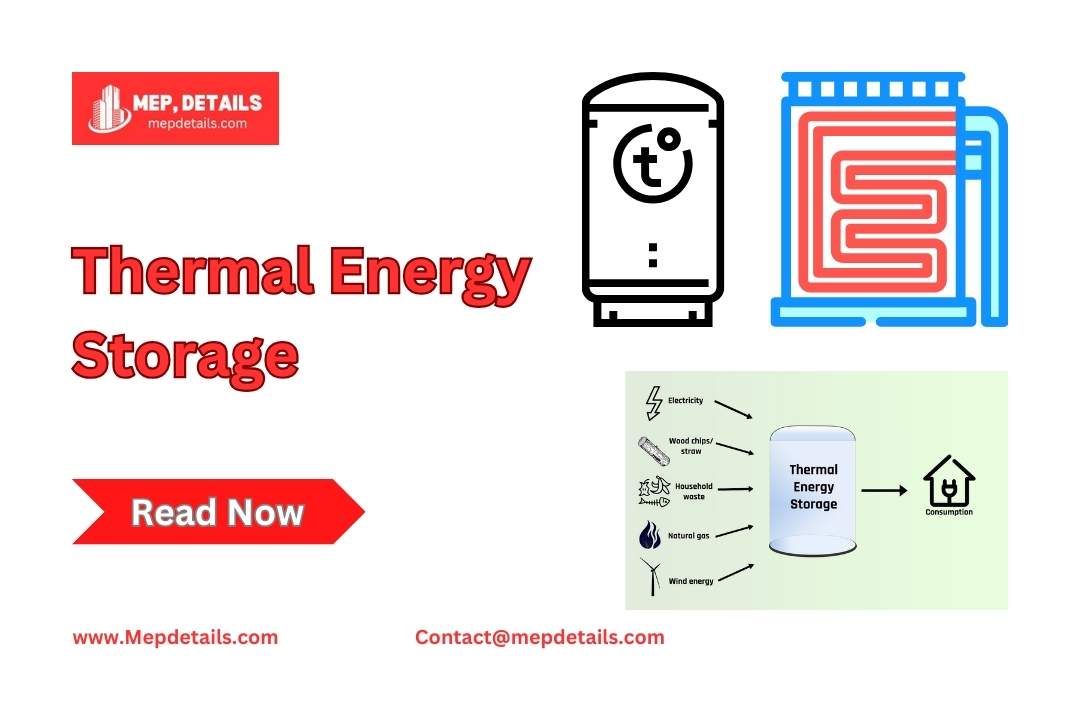Thermal energy storage (TES) lets you save heat for later use. It uses different methods to store extra thermal energy for hours, days, or even months. Storage can be small or large, supporting anything from single processes to entire towns. TES balances energy needs by storing heat from summer for winter or cold from winter for summer. Common storage methods include water tanks, natural earth, bedrock, deep aquifers, and phase-change materials. In this article, we’ll explain what TES is, how it functions, the types, uses, and key benefits it offers.
What is Thermal Energy Storage?
Thermal energy storage involves heating or cooling a material to save the energy for later use. For example, you can heat water in a tank when there’s plenty of energy available, and then use that stored heat when energy is less available. Thermal energy storage helps balance energy use between day and night. Common storage methods include water or ice-slush tanks, underground bedrock or earth accessed through boreholes, and deep underground water reservoirs.
How Does Thermal Energy Storage Work?
During the night, when electricity costs less, a chiller cools water mixed with 25% ethylene glycol. This cooled solution flows through a heat exchanger inside the ice storage tank, freezing 95% of the surrounding water. This water stays inside the tank and does not circulate outside.
Ice forms evenly within the tank through special heat exchange tubes. As ice builds up, water continues to flow, which protects the tank from damage. It takes six to twelve hours to fully charge the ice storage tank.
During the day, when energy costs are higher, the glycol solution flows through the ice storage tank, delivering the stored energy to help cool the building alongside the electric chiller. The cold glycol then moves to the air cooling coil.
A fan blows air over the coil, cooling the spaces for people inside. Occupants feel the cool air but don’t realize that ice storage helps lower cooling costs.
Types of Thermal Energy Storage
There are different ways to store thermal energy, and each method can store extra energy for a few hours, days, or even months. The three main types of thermal energy storage are:
- Sensible Heat Storage: This is a practical option to lower energy use and reduce CO2 emissions. It uses materials like water or rocks to store and release heat, making it a popular choice for homes.
- Latent Heat Storage: This type stores energy without changing the medium’s temperature; instead, it depends on a change in the material’s state. “Phase change materials” can store heat in this way. These materials work well in solar power systems and in buildings to store excess heat.
- Thermochemical Storage: This method stores heat through chemical reactions.
Applications of Thermal Energy Storage
Thermal energy storage works in several areas, such as:
- Concentrating solar power plants, where it supplies power even at night.
- Thermal power plants, where it allows for faster and more flexible load changes.
- Combined heat and power plants, where it ensures a steady heat supply and lets heat and power generation occur at different times.
- Process industries, where it helps capture and use heat that would otherwise go to waste.
Key Benefits of Thermal Energy Storage
Thermal energy storage helps in many ways:
- It lowers peak demand by storing energy during low-demand times and releasing it when demand rises.
- It cuts down on CO2 emissions and saves money by using energy when it’s cheaper and has more renewable sources.
- It improves the overall efficiency of energy systems.
Thermal energy storage also plays a key role in peak shaving systems, where off-peak power runs heat pumps to produce affordable heat or cooling. This setup uses waste heat from industries to help balance energy loads across the system.
Conclusion
Thermal energy storage offers an efficient way to save and use energy across different times of day and seasons. By storing excess heat or cold, it reduces energy costs, lowers carbon emissions, and balances energy demand. TES benefits various sectors, from solar power plants to industrial processes, making energy systems more sustainable. With different storage methods, such as sensible, latent, and thermochemical, thermal energy storage adapts to unique needs, supporting homes, industries, and cities. Embracing TES contributes to a more resilient, cost-effective, and eco-friendly energy future.
FAQs
What is thermal storage?
Thermal storage means storing heat or cold energy in a material to use later. A simple example is heating water in a tank when there’s plenty of energy available. The water stores this energy, which can be used when energy is less available.
Can you give an example of thermal storage?
Some common thermal storage materials include water or ice, natural earth or bedrock heated through boreholes, deep aquifers sealed by impermeable layers, shallow gravel pits with water and insulation, and special materials that change form to store heat.
What is a thermal energy store?
A thermal energy store is a system that stores renewable heat until it’s needed. It often uses a large, insulated tank—also called a buffer or accumulator tank—to store heated water.
How does a thermal storage unit work?
Thermal storage units use electricity at night to heat up clay or ceramic bricks, storing the heat for the next day. They can use electricity during off-peak hours, when it’s cheaper, and release the stored heat during the day.
Read More – Constant Air Volume-CAV: Ideal Applications and Use Cases











